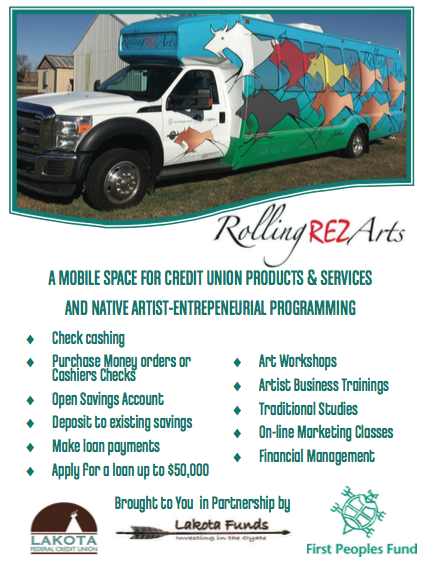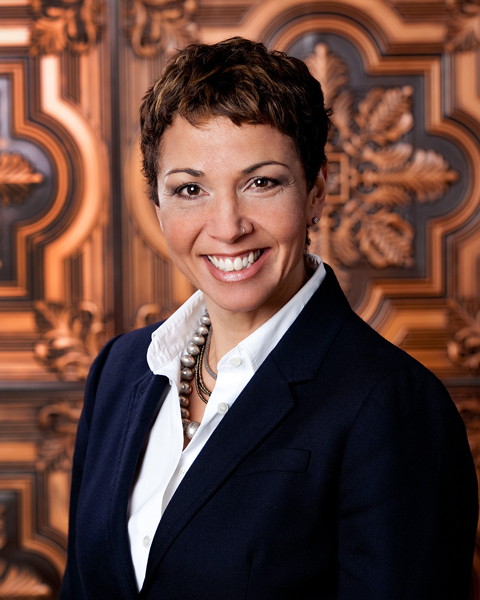It’s hard to get a sense of the vastness of the Pine Ridge Indian Reservation in South Dakota. Bounded by Badlands National Park to the north and the Nebraska border to the south, an estimated 26,000 residents live in or near small communities that dot the countryside.
The Pine Ridge Reservation is a true bank desert. The nearest bank, Security First, is 40 miles away from the center of the reservation in Martin, SD. First National in Gordon, NE, is 50 miles away. And except for a mobile banking van from Security First that made the rounds in parking lots across a few communities, Pine Ridge had never had a federally insured financial institution until Lakota Federal Credit Union ($4.1M, Kyle, SD) opened its doors in 2013.
CU QUICK FACTS
lakota FCU
Data as of 03.31.16
- HQ: Kyle, SD
- ASSETS: $4.1M
- MEMBERS: 2,402
- BRANCHES: 1
- 12-MO SHARE GROWTH: -22..08%
- 12-MO LOAN GROWTH: 10.81%
- ROA: 2.52%
The lack of access to banking services and poverty conditions for Oglala Sioux tribal members had created a mostly cash and prepaid card economy. In fact, a 2012 study found that 60% of residents on the reservation were unbanked.
Today, Lakota FCU has attracted nearly 2,500 members and made more than $2.5 million in loans. Most telling are statistics from a member survey in 2015, which found 31.37% of members had opened a savings account for the first time in their lives and 30.39% were saving more money.
We have a matched savings account for kindergartners and first-graders in which Lakota Funds matches deposits 3-to-1 through eighth grade for educational expenses, says Tawney Brunsch, executive director of Lakota Funds, a community development organization that promotes socio-economic sustainability,and chairman of the board of Lakota FCU. We really get to see the impact. The kindergartner comes in to open his or her first savings, which is no surprise, but it’s also a first account for the mother and maybe even the unci, the grandma, is opening her first account. This is about the individual, but it’s also about the bigger impact on the economy, and that’s exactly what we wanted.
In conjunction with National Financial Literacy month in April, Lakota FCU introduced the Rolling Rez, a mobile banking van painted with colorful Native American art that offers a full range of services to residents, including check cashing, account opening, and loan applications.
 |
| Lakota FCU’s Rolling Rez brings a full range of services to residents, including check cashing, account opening, and loan applications. The vehicle also offers workshops related to financial management. |
The credit union has been swamped since it opened its doors, and Brunsch expects membership to continue to increase as services are expanded across the reservation.
We’re seeing people increase their savings and not having to get title loans, she says. They’re spending less on gas.
Bank Deserts On The Rise
The community served by Lakota FCU poses daunting challenges in terms of distances and getting the word out to potential members, but banking deserts in the United States occur in both rural and urban areas.
In the study Banking the Unbanked: Bank Deserts in the United States, authors Russell D. Kashian, Ran Tao, and Claudia Perez-Valdez of the University of Wisconsin, Whitewater, define a bank desert as an area that has fewer than .02 branches per 1,000 in population. Using postal ZIP code data, the researchers identified 350 urban and 650 rural bank deserts. Those numbers are growing and disproportionally affecting minority populations.
The growing inequality and lack of economic opportunities our country is experiencing has resulted in millions of people becoming disfranchised from the financial mainstream, says Pablo DeFilippi, vice president of membership and business development for the National Federation of Community Development Credit Unions. When a bank closes a branch, there’s an obligation to those communities, and some banks ought to be more responsive to supporting a credit union that’s willing to step in.
DeFilippi has personal experience with bank deserts. Prior to working for the federation, he served as CEO of the Lower East Side People’s FCU ($45.4M, New York, NY), which was established as a result of a Community Reinvestment Act (CRA) challenge to the closure of the last bank branch serving that community.
CRA encourages banks to rebuild and revitalize communities through sound lending and access to services. Stepping in to fill the gap, Lower East Side People’s FCU has helped more than 8,000 mostly Hispanic members access credit, establish savings, and build wealth.
The federation helps low- and moderate-income people and communities achieve financial independence through credit unions. A big responsibility facing all credits unions, DeFilippi says, is finding ways to serve communities that banks have abandoned.
Credit unions that have adapted their business model to meet the needs of low- and middle-income consumers and have modified their underwriting and collection processes to extend loans to these populations are doing well financially, DeFilippi says. More importantly, they’re doing good in these communities.
It Takes a Federally Funded Village
In South Dakota, Brunsch says Lakota FCU would not be here today without help from the government and the surrounding community, including three credit unions in the region, Black Hills Federal Credit Unio ($1.1B, Rapid City, SD), Highmark Federal Credit Union ($109.4M, Rapid City, SD), and Sentinel Federal Credit Union ($107.29M, Box Elder, SD), which committed to being the new credit union’s first depositors.
The U.S. Department of the Treasury also played a major role through its Community Development Financial Institutions (CDFI) Fund.
Last year, Lakota FCU received $750,000 from the Native American CDFI Assistance Program, created by Congress in 1992 to increase access to credit, capital, and financial services to Native Communities. Treasury grants covered startup costs and staff salaries for the credit union’s four employees.
We wouldn’t have been able to get it off the ground without this support, Brunsch says.
Having a credit union on the Pine Ridge Reservation has always been a dream for Brunsch. She spent eight years working at Black Hills FCU covering almost every position, including branch manager, before taking over the reins at Lakota Funds.
I’m a big believer in credit unions and the fact that they’re member-owned, Brunsch says. You can see the power of credit unions and how they can change lives.
 |
| Tawney Brunsch, Board Chair, Lakota FCU |
Lakota Funds, founded more than 30 years ago, is one of the oldest Native American CDFI-funded entities, focused on business development, employment, and training on the reservation. Lakota Fund’s loan portfolio exceeds $7 million, with a maximum loan size of $300,000. Since 1986, it has helped thousands of artists and aspiring entrepreneurs, created more than 1,400 permanent jobs, and helped establish hundreds of businesses.
Lakota Funds, however, cannot accept deposits or make auto loans, so a significant amount of money was leaving the reservation every month. Tribal elders approached Lokota Funds regarding the March 1, 2013, deadline when all Social Security checks and other federal benefits were to be distributed electronically only. They feared unbanked tribal members would stop receiving their checks.
Demonstrating The Need
Lakota Funds pledged its support, including free office space for the new credit union in the Lakota Trade Center, but Brunsch says NCUA officials had a difficult time seeing beyond the major challenges to the opportunity the application presented.
We’re seeing people increase their savings and not having to get title loans.
The reservation is located in the nation’s third-poorest county, and average annual income is well below the national average, so the NCUA questioned the demand for loans. Brunsch had to convince a representative to visit the reservation to witness firsthand the area’s poor access to financial services.
It wasn’t until he saw how remote we are that he understood the need for a credit union, Brunsch says. There are no city blocks. There isn’t ATM access in every community, and the communities are 50 miles apart.
Lakota FCU received its charter from the NCUA on Aug. 29, 2012, and conducted a soft launch less than three months later. The credit union offers savings, secured loans up to $50,000, unsecured term loans, and lines of credit up to $5,000.
We’ll take any type of collateral, including a horse trailer or a four-wheeler, Brunsch says.
So far, 12% of members have purchased new vehicles with Lakota FCU loans.
Next Steps
In addition to increasing banking services in its communities through the Rolling Rez, Lakota FCU plans to offer checking accounts. The credit union already offers online banking and members use pre-paid debit cards for most transactions. Checking and debit cards will give members access to thousands of shared-branch ATMs, extending the reach of Lakota FCU.
Two telling statistics about Lakota FCU: It has virtually no debt, so its ROA was 2.5% as of first quarter 2016, and even though it’s in one of the poorest areas of the country, delinquent loans account for only 4.2% of the total portfolio. That’s not so bad when compared to the 1.9% average reported by all credit unions with $2 million to $5 million in assets.
Our members are people who save and who repay, and I attribute that to relationships, Brunsch says. They understand the $5 to open their account reflects their ownership in this credit union. Our whole staff is from here. We know everybody, so it’s a very user-friendly environment.
You Might Also Enjoy
- Financial Wellness Is A Big Idea For 2016
- Financial Wellness In America
- A Strategy To Build Financial Wellness And The Bottom Line
- How Patelco Is Helping Members Achieve Savings Goals